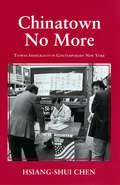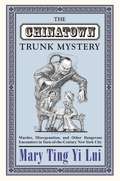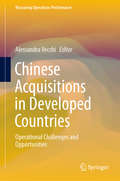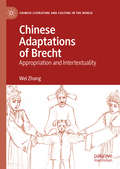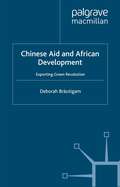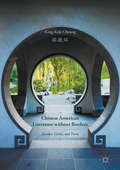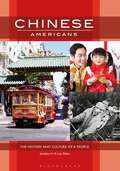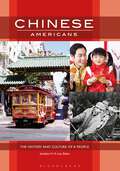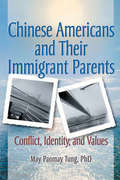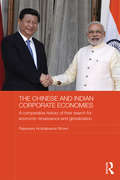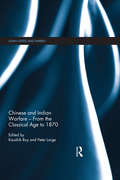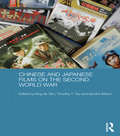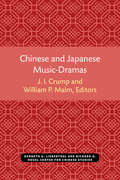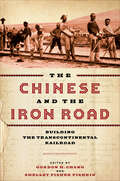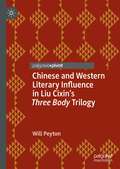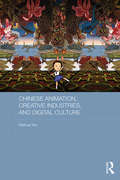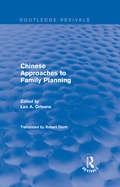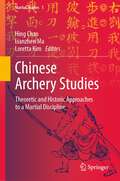- Table View
- List View
Chinatown No More: Taiwan Immigrants in Contemporary New York (The Anthropology of Contemporary Issues)
by Hsiang-Shui ChenBy focusing on the social and cultural life of post-1965 Taiwan immigrants in Queens, New York, this book shifts Chinese American studies from ethnic enclaves to the diverse multiethnic neighborhoods of Flushing and Elmhurst. As Hsiang-shui Chen documents, the political dynamics of these settlements are entirely different from the traditional closed Chinese communities; the immigrants in Queens think of themselves as living in "worldtown," not in a second Chinatown. Drawing on interviews with members of a hundred households, Chen brings out telling aspects of demography, immigration experience, family life, and gender roles, and then turns to vivid, humanistic portraits of three families. Chen also describes the organizational life of the Chinese in Queens with a lively account of the power struggles and social interactions that occur within religious, sports, social service, and business groups and with the outside world.
The Chinatown Trunk Mystery: Murder, Miscegenation, and Other Dangerous Encounters in Turn-of-the-Century New York City
by Mary Ting LuiIn the summer of 1909, the gruesome murder of nineteen-year-old Elsie Sigel sent shock waves through New York City and the nation at large. The young woman's strangled corpse was discovered inside a trunk in the midtown Manhattan apartment of her reputed former Sunday school student and lover, a Chinese man named Leon Ling. Through the lens of this unsolved murder, Mary Ting Yi Lui offers a fascinating snapshot of social and sexual relations between Chinese and non-Chinese populations in turn-of-the-century New York City. Sigel's murder was more than a notorious crime, Lui contends. It was a clear signal that attempts to maintain geographical and social boundaries between the city's Chinese male and white female populations had failed. When police discovered Sigel and Leon Ling's love letters, giving rise to the theory that Leon Ling killed his lover in a fit of jealous rage, this idea became even more embedded in the public consciousness. New Yorkers condemned the work of Chinese missions and eagerly participated in the massive national and international manhunt to locate the vanished Leon Ling. Lui explores how the narratives of racial and sexual danger that arose from the Sigel murder revealed widespread concerns about interracial social and sexual mixing during the era. She also examines how they provoked far-reaching skepticism about regulatory efforts to limit the social and physical mobility of Chinese immigrants and white working-class and middle-class women. Through her thorough re-examination of this notorious murder, Lui reveals in unprecedented detail how contemporary politics of race, gender, and sexuality shaped public responses to the presence of Chinese immigrants during the Chinese exclusion era.
The Chinatown Trunk Mystery: Murder, Miscegenation, and Other Dangerous Encounters in Turn-of-the-Century New York City
by Mary Ting LuiIn the summer of 1909, the gruesome murder of nineteen-year-old Elsie Sigel sent shock waves through New York City and the nation at large. The young woman's strangled corpse was discovered inside a trunk in the midtown Manhattan apartment of her reputed former Sunday school student and lover, a Chinese man named Leon Ling. Through the lens of this unsolved murder, Mary Ting Yi Lui offers a fascinating snapshot of social and sexual relations between Chinese and non-Chinese populations in turn-of-the-century New York City. Sigel's murder was more than a notorious crime, Lui contends. It was a clear signal that attempts to maintain geographical and social boundaries between the city's Chinese male and white female populations had failed. When police discovered Sigel and Leon Ling's love letters, giving rise to the theory that Leon Ling killed his lover in a fit of jealous rage, this idea became even more embedded in the public consciousness. New Yorkers condemned the work of Chinese missions and eagerly participated in the massive national and international manhunt to locate the vanished Leon Ling. Lui explores how the narratives of racial and sexual danger that arose from the Sigel murder revealed widespread concerns about interracial social and sexual mixing during the era. She also examines how they provoked far-reaching skepticism about regulatory efforts to limit the social and physical mobility of Chinese immigrants and white working-class and middle-class women. Through her thorough re-examination of this notorious murder, Lui reveals in unprecedented detail how contemporary politics of race, gender, and sexuality shaped public responses to the presence of Chinese immigrants during the Chinese exclusion era.
Chinese Acquisitions in Developed Countries: Operational Challenges and Opportunities (Measuring Operations Performance)
by Alessandra VecchiThis book assesses Chinese acquisitions in developed countries, evaluates the drivers and opportunities and, above all, explores the major operational challenges. It discusses topics such as cross-cultural issues, integration strategies, risk and resilience, the influence of emerging technologies, servitization, impacts on reshoring, corporate social responsibility, branding strategies, knowledge management, and transfer of best practices. While emerging market multinational corporations’ (EMNCs) use of mergers and acquisitions as a strategic vehicle has received considerable attention, much less is known about their post-entry activities, such as the implementation of post-acquisition and integration strategies. It can be expected that, compared with their Western counterparts, EMNCs will face radically different challenges that may undermine the success of their products, brands and marketing. Addressing these issues by means of a case study approach, this book is an ideal teaching resource for a variety of courses at both undergraduate and postgraduate level. It also appeals to academics, researchers, and practitioners with a keen interest in manufacturing industry.
Chinese Adaptations of Brecht: Appropriation and Intertextuality (Chinese Literature and Culture in the World)
by Wei ZhangThis book examines the two-way impacts between Brecht and Chinese culture and drama/theatre, focusing on Chinese theatrical productions since the end of the Cultural Revolution all the way to the first decades of the twenty-first century. Wei Zhang considers how Brecht’s plays have been adapted/appropriated by Chinese theatre artists to speak to the sociopolitical, economic, and cultural developments in China and how such endeavors reflect and result from dynamic interactions between Chinese philosophy, ethics, and aesthetics, especially as embodied in traditional xiqu and the Brechtian concepts of estrangement (Verfremdungseffekt) and political theatre. In examining these Brecht adaptations, Zhang offers an interdisciplinary study that contributes to the fields of comparative drama/theatre studies, intercultural studies, and performance studies.
Chinese Aid and African Development: Exporting Green Revolution (International Political Economy Series)
by D. BräutigamSince 1957, more than 45 African countries have received aid from China, yet until recently little has been known about the effectiveness or impact of this assistance. Bräutigam provides the first authoritative account of China's experience as an aid donor in rural Africa. In a detailed and highly readable analysis, the author draws on anthropology, economics, organization theory and political science to explain how China's domestic agenda shaped the design of its aid, and how domestic politics in African countries influenced its outcome.
Chinese American Literature without Borders: Gender, Genre, and Form
by King-Kok CheungThis book bridges comparative literature and American studies by using an intercultural and bilingual approach to Chinese American literature. King-Kok Cheung launches a new transnational exchange by examining both Chinese and Chinese American writers. Part 1 presents alternative forms of masculinity that transcend conventional associations of valor with aggression. It examines gender refashioning in light of the Chinese dyadic ideal of wen-wu (verbal arts and martial arts), while redefining both in the process. Part 2 highlights the writers’ formal innovations by presenting alternative autobiography, theory, metafiction, and translation. In doing so, Cheung puts in relief the literary experiments of the writers, who interweave hybrid poetics with two-pronged geopolitical critiques. The writers examined provide a reflexive lens through which transpacific audiences are beckoned to view the “other” country and to look homeward without blinders.
Chinese Americans: The History and Culture of a People
by Jonathan H. X. LeeThis in-depth historical analysis highlights the enormous contributions of Chinese Americans to the professions, politics, and popular culture of America, from the 19th century through the present day.While the number of Chinese Americans has grown very rapidly in the last decade, this group has long thrived in the United States in spite of racism, discrimination, and segregation. This comprehensive volume takes a global view of the Chinese experience in the Americas. While the focus is on Chinese Americans in the United States, author Jonathan H. X. Lee also explores the experiences of Chinese immigrants in Canada, Mexico, and South America. He considers why the Chinese chose to leave their home country, where they settled, and how the distinctive Chinese American identity was formed.This volume is organized into four sections: historical overview; political and economic life; cultural and religious life; and literature, the arts, and popular culture. Detailed essays capture the essence of everyday life for this immigrant group as they assimilated, established communities, and interacted with other ethnic groups. Alphabetically arranged entries describe the political, social, and religious institutions begun by Chinese Americans and explores their roles as business owners, activists, and philanthropic benefactors for their communities.
Chinese Americans: The History and Culture of a People
by Jonathan H. X. LeeThis in-depth historical analysis highlights the enormous contributions of Chinese Americans to the professions, politics, and popular culture of America, from the 19th century through the present day.While the number of Chinese Americans has grown very rapidly in the last decade, this group has long thrived in the United States in spite of racism, discrimination, and segregation. This comprehensive volume takes a global view of the Chinese experience in the Americas. While the focus is on Chinese Americans in the United States, author Jonathan H. X. Lee also explores the experiences of Chinese immigrants in Canada, Mexico, and South America. He considers why the Chinese chose to leave their home country, where they settled, and how the distinctive Chinese American identity was formed.This volume is organized into four sections: historical overview; political and economic life; cultural and religious life; and literature, the arts, and popular culture. Detailed essays capture the essence of everyday life for this immigrant group as they assimilated, established communities, and interacted with other ethnic groups. Alphabetically arranged entries describe the political, social, and religious institutions begun by Chinese Americans and explores their roles as business owners, activists, and philanthropic benefactors for their communities.
Chinese Americans and Their Immigrant Parents: Conflict, Identity, and Values
by Terry S Trepper May TungBased on culture-related themes derived from the author's psychotherapeutic work with young Chinese-American professionals, this important book relates personal problems and conditions to specific sources in Chinese and American cultures and the immigration experience. Unique and practical, this is a nonclinical work that will help Asian Americans connect historical and cultural meanings to their Chinese roots. It will also give educators, mental health professionals, and those working with Chinese populations firsthand insight into the lives and identities of Chinese-American immigrants. Exploring the meaning and arrangement of Chinese family names, the bonds among family members, and the different contexts of “self” to Chinese Americans, this valuable book offers you insight into the dilemma between “self” and “family” that both the younger and older generations must face in American society. In order to help you understand Chinese immigrants or help your clients, Chinese Americans and Their Immigrant Parents provides you with information about several differences found between the two cultures, such as: understanding that words and concepts may not relate to the same emotions or translate exactly between languages realizing that strong family bonds of the Chinese fosters interdependence, unlike Americans who admire self-assertiveness and independence recognizing the fear that Chinese immigrant parents have of losing their strong family ties and seeing their children forsake customs because they do not want to be seen as “different” discovering why risk-taking and adventurous acts are discouraged by many Chinese parents comprehending the great importance to Chinese parents of continuing their family and raising successful children acknowledging the different roles of men and women within several different contexts in American and Chinese societiesWith personal vignettes, humor, and interesting insights, Chinese Americans and Their Immigrant Parents: Conflict, Identity, and Values demonstrates how some Chinese Americans are connecting historical and cultural meanings to their Chinese roots and bridging generational gaps between themselves and their parents to create a truly cross-cultural identity.
Chinese Americans and Their Immigrant Parents: Conflict, Identity, and Values
by Terry S Trepper May TungBased on culture-related themes derived from the author's psychotherapeutic work with young Chinese-American professionals, this important book relates personal problems and conditions to specific sources in Chinese and American cultures and the immigration experience. Unique and practical, this is a nonclinical work that will help Asian Americans connect historical and cultural meanings to their Chinese roots. It will also give educators, mental health professionals, and those working with Chinese populations firsthand insight into the lives and identities of Chinese-American immigrants. Exploring the meaning and arrangement of Chinese family names, the bonds among family members, and the different contexts of “self” to Chinese Americans, this valuable book offers you insight into the dilemma between “self” and “family” that both the younger and older generations must face in American society. In order to help you understand Chinese immigrants or help your clients, Chinese Americans and Their Immigrant Parents provides you with information about several differences found between the two cultures, such as: understanding that words and concepts may not relate to the same emotions or translate exactly between languages realizing that strong family bonds of the Chinese fosters interdependence, unlike Americans who admire self-assertiveness and independence recognizing the fear that Chinese immigrant parents have of losing their strong family ties and seeing their children forsake customs because they do not want to be seen as “different” discovering why risk-taking and adventurous acts are discouraged by many Chinese parents comprehending the great importance to Chinese parents of continuing their family and raising successful children acknowledging the different roles of men and women within several different contexts in American and Chinese societiesWith personal vignettes, humor, and interesting insights, Chinese Americans and Their Immigrant Parents: Conflict, Identity, and Values demonstrates how some Chinese Americans are connecting historical and cultural meanings to their Chinese roots and bridging generational gaps between themselves and their parents to create a truly cross-cultural identity.
The Chinese and Indian Corporate Economies: A Comparative History of their Search for Economic Renaissance and Globalization (Routledge Studies in the Growth Economies of Asia)
by Raj BrownThis is a compelling analysis of the corporate economies of China and India, which are having a huge impact not just on the international economy, but also in the geopolitical and international strategy sphere as a result of an accelerated globalisation by these two countries, which is unleashing powerful economic challenges to corporate structures, economic institutions and law worldwide. The big question is how after centuries of underdevelopment China and now India are emerging powerfully and pulling ahead of Western European economies. Analysing the role of the state and the adroit use of law, and their impact on the corporate evolution of both China and India, provides greater clarity and insight into why China has evolved as a manufacturing nation utilizing cheap abundant labour while India has not exploited such advantages but instead focused on IT and higher value industries, even abroad as Tata has demonstrated in the motor industry in Europe. Again while Chinese corporations have expanded abroad as an arm of the state into Asia, Middle East, Africa, Europe, Latin America and parts of the southern states of the USA, India has pushed principally into Europe through the efforts of powerful minority capitalists of Parsi and Gujerati background, overcoming technological gaps and differences through acquisitions and absorptions of existing corporations in particular industries, especially in steel, automobiles and textiles. In China, state owned corporations have been dominant. In India, though state owned enterprises have been powerful since 1951, it has been private capitalists with an established stronghold since the colonial period and even under the Socialist period from 1951-1991 who have been the more productive main actors both in India and abroad.
The Chinese and Indian Corporate Economies: A Comparative History of their Search for Economic Renaissance and Globalization (Routledge Studies in the Growth Economies of Asia)
by Raj BrownThis is a compelling analysis of the corporate economies of China and India, which are having a huge impact not just on the international economy, but also in the geopolitical and international strategy sphere as a result of an accelerated globalisation by these two countries, which is unleashing powerful economic challenges to corporate structures, economic institutions and law worldwide. The big question is how after centuries of underdevelopment China and now India are emerging powerfully and pulling ahead of Western European economies. Analysing the role of the state and the adroit use of law, and their impact on the corporate evolution of both China and India, provides greater clarity and insight into why China has evolved as a manufacturing nation utilizing cheap abundant labour while India has not exploited such advantages but instead focused on IT and higher value industries, even abroad as Tata has demonstrated in the motor industry in Europe. Again while Chinese corporations have expanded abroad as an arm of the state into Asia, Middle East, Africa, Europe, Latin America and parts of the southern states of the USA, India has pushed principally into Europe through the efforts of powerful minority capitalists of Parsi and Gujerati background, overcoming technological gaps and differences through acquisitions and absorptions of existing corporations in particular industries, especially in steel, automobiles and textiles. In China, state owned corporations have been dominant. In India, though state owned enterprises have been powerful since 1951, it has been private capitalists with an established stronghold since the colonial period and even under the Socialist period from 1951-1991 who have been the more productive main actors both in India and abroad.
Chinese and Indian Warfare - From the Classical Age to 1870 (Asian States and Empires)
by Kaushik Roy Peter LorgeThis book examines the differences and similarities between warfare in China and India before 1870, both conceptually and on the battlefield. By focusing on Chinese and Indian warfare, the book breaks the intellectual paradigm requiring non-Western histories and cultures to be compared to the West, and allows scholarship on two of the oldest civilizations to be brought together. An international group of scholars compare and contrast the modes and conceptions of warfare in China and India, providing important original contributions to the growing study of Asian military history.
Chinese and Indian Warfare - From the Classical Age to 1870 (Asian States and Empires)
by Kaushik Roy Peter LorgeThis book examines the differences and similarities between warfare in China and India before 1870, both conceptually and on the battlefield. By focusing on Chinese and Indian warfare, the book breaks the intellectual paradigm requiring non-Western histories and cultures to be compared to the West, and allows scholarship on two of the oldest civilizations to be brought together. An international group of scholars compare and contrast the modes and conceptions of warfare in China and India, providing important original contributions to the growing study of Asian military history.
Chinese and Japanese Films on the Second World War (Media, Culture and Social Change in Asia)
by King-Fai Tam Timothy Y. Tsu Sandra WilsonThis book examines representations of the Second World War in postwar Chinese and Japanese cinema. Drawing on a wide range of scholarly disciplines, and analysing a wide range of films, it demonstrates the potential of war movies for understanding contemporary China and Japan. It shows how the war is remembered in both countries, including the demonisation of Japanese soldiers in postwar socialist-era Chinese movies, and the pervasive sense of victimhood in Japanese memories of the war. However, it also shows how some Chinese directors were experimenting with alternatives interpretations of the war from as early as the 1950s, and how, despite the "resurgence of nationalism" in japan since the 1980s, the production of Japanese movies critical of the war has continued.
Chinese and Japanese Films on the Second World War (Media, Culture and Social Change in Asia)
by King-Fai Tam Timothy Y. Tsu Sandra WilsonThis book examines representations of the Second World War in postwar Chinese and Japanese cinema. Drawing on a wide range of scholarly disciplines, and analysing a wide range of films, it demonstrates the potential of war movies for understanding contemporary China and Japan. It shows how the war is remembered in both countries, including the demonisation of Japanese soldiers in postwar socialist-era Chinese movies, and the pervasive sense of victimhood in Japanese memories of the war. However, it also shows how some Chinese directors were experimenting with alternatives interpretations of the war from as early as the 1950s, and how, despite the "resurgence of nationalism" in japan since the 1980s, the production of Japanese movies critical of the war has continued.
Chinese and Japanese Music-Dramas (Michigan Monographs In Chinese Studies #19)
by J. I. CrumpChinese and Japanese Music-Dramas is the result of a conference on the relations between Chinese and Japanese music-drama held at the University of Michigan, Ann Arbor, on October 1–4, 1971. In addition to the Association for Asian Studies, four U-M departments participated in the conference: the Center for Japanese Studies, the Center for Chinese Studies, the School of Music, and the Speech Department. One important inspiration for the creation of such an interdisciplinary conference was the fact that each participant had found, after years of individual research on music-drama in East Asia, consistent frustration caused by attempts to deal on their own with multiple cultural and technical problems. Another motivating force was an awareness among many members of the four disciplines involved that the topic is in fact one of the largest untouched fields of scholarly endeavor in both Asian and theatrical studies. The collection opens with J. I. Crump’s exploration of the Ming commentators who began to subject Yüan musical drama to the same critiques as other literature from the past. In the second chapter, Rulan Chao Pian looks to the structure of arias in Peking Opera for clues about what distinguishes this art form. William P. Malm turns to three key sources for the performance conventions of Japanese Noh drama to glean any Sino-Japanese music relationships that exist in technical terms and practices. In the fourth essay, Carl Sesar analyzes a Noh play that stages the tension between Chinese influence and Japanese originality. Roy E Teele concludes the volume with a formal study of Noh play structure to assess lineages of influence from Chinese dramatic forms. After each contribution, the editors print a transcript of the conference participants’ discussion of that paper, providing the reader with a detailed and nuanced view of how the contributors understood and responded to each other’s work.
The Chinese and the Iron Road: Building the Transcontinental Railroad (Asian America)
by Gordon H. Chang and Shelley Fisher FishkinThe completion of the transcontinental railroad in May 1869 is usually told as a story of national triumph and a key moment for American Manifest Destiny. The Railroad made it possible to cross the country in a matter of days instead of months, paved the way for new settlers to come out west, and helped speed America's entry onto the world stage as a modern nation that spanned a full continent. It also created vast wealth for its four owners, including the fortune with which Leland Stanford would found Stanford University some two decades later. But while the Transcontinental has often been celebrated in national memory, little attention has been paid to the Chinese workers who made up 90 percent of the workforce on the Western portion of the line. The Railroad could not have been built without Chinese labor, but the lives of Chinese railroad workers themselves have been little understood and largely invisible. This landmark volume explores the experiences of Chinese railroad workers and their place in cultural memory. The Chinese and the Iron Road illuminates more fully than ever before the interconnected economies of China and the US, how immigration across the Pacific changed both nations, the dynamics of the racism the workers encountered, the conditions under which they labored, and their role in shaping both the history of the railroad and the development of the American West.
Chinese and Western Literary Influence in Liu Cixin’s Three Body Trilogy (Studies in Global Science Fiction)
by Will PeytonChinese and Western Literary Influence in Liu Cixin’s Three Body Trilogy examines Liu Cixin’s acclaimed trilogy, a Chinese science fiction epic whose translation is exceedingly popular in the Western world. Will Peyton argues that the ingenuity of Liu’s writing is found in its conscious engagement with translated Western fiction rather than, as one might expect, in Chinese language science fiction of the past. The book illustrates how contemporary Chinese fiction, since the economic opening of China in the late 1980s, is deeply and complexly influenced by various strains in Western literary and intellectual thought, an area that scholars of Chinese literature have tended to neglect. Providing a lucid and succinct close-reading and textual analysis of Three Body trilogy, the book also makes reference to broader ideas and themes in modern Chinese and Western intellectual history.
Chinese Animation, Creative Industries, and Digital Culture (Routledge Culture, Society, Business in East Asia Series)
by Weihua WuThis book explores the development of the Chinese animation film industry from the beginning of China’s reform process up to the present. It discusses above all the relationship between the communist state’s policies to stimulate "creative industries", concepts of creativity and aesthetics, and the creation and maintenance , through changing circumstances, of a national style by Chinese animators. The book also examines the relationship between Chinese animation, changing technologies including the rise first of television and then of digital media, and youth culture, demonstrating the importance of Chinese animation in Chinese youth culture in the digital age.
Chinese Animation, Creative Industries, and Digital Culture (Routledge Culture, Society, Business in East Asia Series)
by Weihua WuThis book explores the development of the Chinese animation film industry from the beginning of China’s reform process up to the present. It discusses above all the relationship between the communist state’s policies to stimulate "creative industries", concepts of creativity and aesthetics, and the creation and maintenance , through changing circumstances, of a national style by Chinese animators. The book also examines the relationship between Chinese animation, changing technologies including the rise first of television and then of digital media, and youth culture, demonstrating the importance of Chinese animation in Chinese youth culture in the digital age.
Chinese Approaches to Family Planning (Routledge Revivals)
by Robert Dunn Leo A. OrleansThis title was first published in 1980. Years of experience have shown that the successful introduction of family planning into a rural, tradition-bound society essentially depends on how efficiently the authorities can educate and motivate the targeted population. But while China’s impressive family planning successes in the 1970s have, to a large extent, resulted from innovative methods of communication and motivation, it has also continued to rely on the more orthodox means of persuasion, such as the media, pamphlets, posters, lantern slides, personal testimonies, and so forth. The pattern in a ll the m aterials is very similar: problem, ideological struggle, happy ending. This volume is a look the materials the People' s Health Press printed and distributed of more than 300,000 copies of information on Chinese birth control.
Chinese Approaches to Family Planning (Routledge Revivals)
by Leo A. OrleansThis title was first published in 1980. Years of experience have shown that the successful introduction of family planning into a rural, tradition-bound society essentially depends on how efficiently the authorities can educate and motivate the targeted population. But while China’s impressive family planning successes in the 1970s have, to a large extent, resulted from innovative methods of communication and motivation, it has also continued to rely on the more orthodox means of persuasion, such as the media, pamphlets, posters, lantern slides, personal testimonies, and so forth. The pattern in a ll the m aterials is very similar: problem, ideological struggle, happy ending. This volume is a look the materials the People' s Health Press printed and distributed of more than 300,000 copies of information on Chinese birth control.
Chinese Archery Studies: Theoretic and Historic Approaches to a Martial Discipline (Martial Studies #1)
by Hing Chao Lianzhen Ma Loretta KimThis book, the first research publication on China’s archery culture to appear in the English language, introduces the historic development, key concepts, and research methodologies for archery studies. Archery was the most important weapon of war in pre-modern China; at the same time, archery practice was intimately tied to Confucius’ cultural and pedagogic ideals. Chinese archery was divided into the domains of military archery (wushe) and ritual archery (lishe), and may be further distinguished into han (Chinese) and hu (barbarian) archery traditions. Bringing together the leading scholars in this field, including Ma Mingda, Stephen Selby, Ma Lianzhen, Peter Dekker, and others, this book presents the most comprehensive statement on archery studies to date. In particular, it provides an in-depth survey of archery development during the Qing period and offers a unique cultural perspective to understanding China’s last imperial dynasty—through the lens of Manchu archery.
